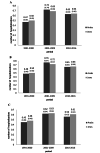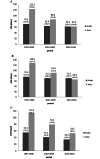Patterns of psychiatric hospitalizations of Arab and Jewish adults with chronic psychotic disorders, before and after national mental health reforms, Israel, 1991-2016
- PMID: 37670229
- PMCID: PMC10478495
- DOI: 10.1186/s12888-023-05132-w
Patterns of psychiatric hospitalizations of Arab and Jewish adults with chronic psychotic disorders, before and after national mental health reforms, Israel, 1991-2016
Abstract
Background: Members of the Arab minority in Israel are at increased risk of developing mental illness, although less likely to seek care and have accessible treatment. This study compares trends in psychiatric hospitalizations between Arabs and Jews with chronic psychotic disorders, before and after introduction of the Community Rehabilitation of Persons with Mental Disability Law in 2000, and governmental recognition of the need to allocate resources for patients with co-occurring substance use disorder and mental illness in 2010.
Methods: The National Psychiatric Case Registry provided data on 18,684 adults with schizophrenia/schizoaffective disorder, hospitalized in 1991-2016 (at least once in 2010-2015). Repeated-measures ANOVA was used to measure the effect (and interactions) of population-group (Arabs and Jews), time-period (Period1: 1991-2000, Period2: 2001-2009, Period3: 2010-2016) and sex, on average length of stay (LOS), annual number of hospitalizations and hospitalization days.
Results: The proportion of Arab patients hospitalized with a diagnosis of chronic psychotic disorder (14.4%) was significantly lower than their proportion in the general population (21%), and their average age at first hospitalization (28.4 years) was older than that of Jewish inpatients (27.0 years). The average number of hospitalization days and LOS of Jewish patients were double that of Arab patients in Period1. Following implementation of the Rehabilitation Law, hospitalization days increased among Arab patients and decreased slightly among Jewish patients, such that by Period3 the average number of hospitalization days was similar among Jewish (41) and Arab (37) patients. The increase in hospitalization days among Arab patients was limited to men with no change noted among women. The number of hospitalization days among Arab women was about half that of Jewish women (p < 0.0001).
Conclusions: The findings reveal a narrowing of disparities in psychiatric hospitalizations between Arab and Jewish patients in Israel over time. However, among Arab women the number of hospitalization days remains considerably lower than that of Jewish women, raising concerns that Arab women may be receiving insufficient care. Further study is needed to fully understand the underpinnings of these disparities, although increasing the number of Arabic-language mental health services and providing psycho-education, will help further close the gap.
Keywords: Arabs; Chronic psychotic disorders; Ethnic minority; Jews; National psychiatric registry; Psychiatric hospitalization; Schizophrenia; Sex differences.
© 2023. BioMed Central Ltd., part of Springer Nature.
Conflict of interest statement
The authors declare no competing interests.
Figures



Similar articles
-
Ethnic inequalities in community rehabilitation use and psychiatric hospitalizations among people with chronic psychotic disorder.Soc Psychiatry Psychiatr Epidemiol. 2024 Jul;59(7):1235-1242. doi: 10.1007/s00127-023-02551-8. Epub 2023 Aug 24. Soc Psychiatry Psychiatr Epidemiol. 2024. PMID: 37615710
-
Differential Effect of Community Rehabilitation Reform on Hospitalizations of Patients with Chronic Psychotic Disorders With and Without Substance Use Disorder, Israel, 1991-2016.Adm Policy Ment Health. 2021 Mar;48(2):354-362. doi: 10.1007/s10488-020-01077-4. Adm Policy Ment Health. 2021. PMID: 32780219
-
Psychiatric Hospitalizations of Chronic Psychotic Disorder Patients With and Without Dual Diagnosis, Israel, 1963-2016.J Dual Diagn. 2019 Jul-Sep;15(3):130-139. doi: 10.1080/15504263.2019.1609149. Epub 2019 May 12. J Dual Diagn. 2019. PMID: 31079564
-
Social Support for Arab People with Chronic Conditions: A Scoping Review.Clin Nurs Res. 2021 May;30(4):380-391. doi: 10.1177/1054773820932262. Epub 2020 Jun 5. Clin Nurs Res. 2021. PMID: 32501107
-
Community mental healthcare in Lebanon.Consort Psychiatr. 2020 Sep 2;1(1):71-77. doi: 10.17650/2712-7672-2020-1-1-71-77. Consort Psychiatr. 2020. PMID: 38680384 Free PMC article. Review.
References
-
- Coid JW, Kirkbride JB, Barker D et al. Raised incidence rates of all psychoses among migrant groups: findings from the East London first episode psychosis study [published correction appears in Arch Gen Psychiatry. 2009;66(2):161]. Arch Gen Psychiatry. 2008;65(11):1250-8. 10.1001/archpsyc.65.11.1250. - PubMed
MeSH terms
LinkOut - more resources
Full Text Sources
Medical
Miscellaneous

